Key takeaways:
- Introducing financial concepts through relatable examples, like trading Pokémon cards, helps children grasp complex ideas like cryptocurrency and savings.
- Engaging children in financial decisions fosters ownership and understanding of the value of money, turning saving into a fun and adventurous process.
- Celebrating small milestones and incorporating storytelling makes saving an enjoyable journey, reinforcing motivation and connection to financial goals.
- Regular discussions about saving experiences and goals promote open dialogue about money and empower children to learn from shared journeys.
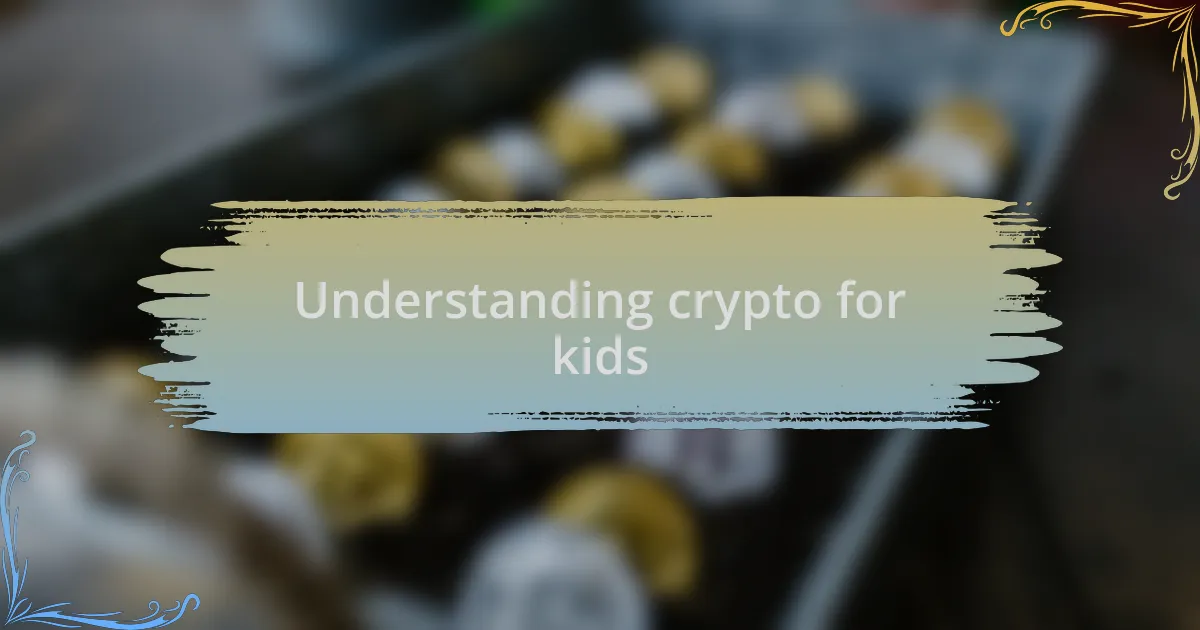
Understanding crypto for kids
When I first introduced my child to the concept of cryptocurrency, I realized it needed a different approach than traditional money. Crypto isn’t just digital cash; it represents a whole new way of thinking about value. Have you ever thought about how exciting it is to consider owning a piece of something intangible yet powerful?
One afternoon, we sat together and explored a simple chart of Bitcoin’s rise. Watching the numbers jump and fall sparked curiosity in my child. It reminded me of how I felt when I first learned about stocks—there’s a spark of possibility that comes with understanding these digital assets. Kids have this unique ability to embrace concepts with wonder, which makes them more open to learning.
Talking about crypto might sound complex, but I found that breaking it down into relatable terms helps. For instance, I likened it to trading Pokémon cards—each card has its own value, just like different cryptocurrencies. This connection helped my child grasp why people invest in crypto. Don’t you think making these comparisons can turn a daunting topic into a fun adventure?
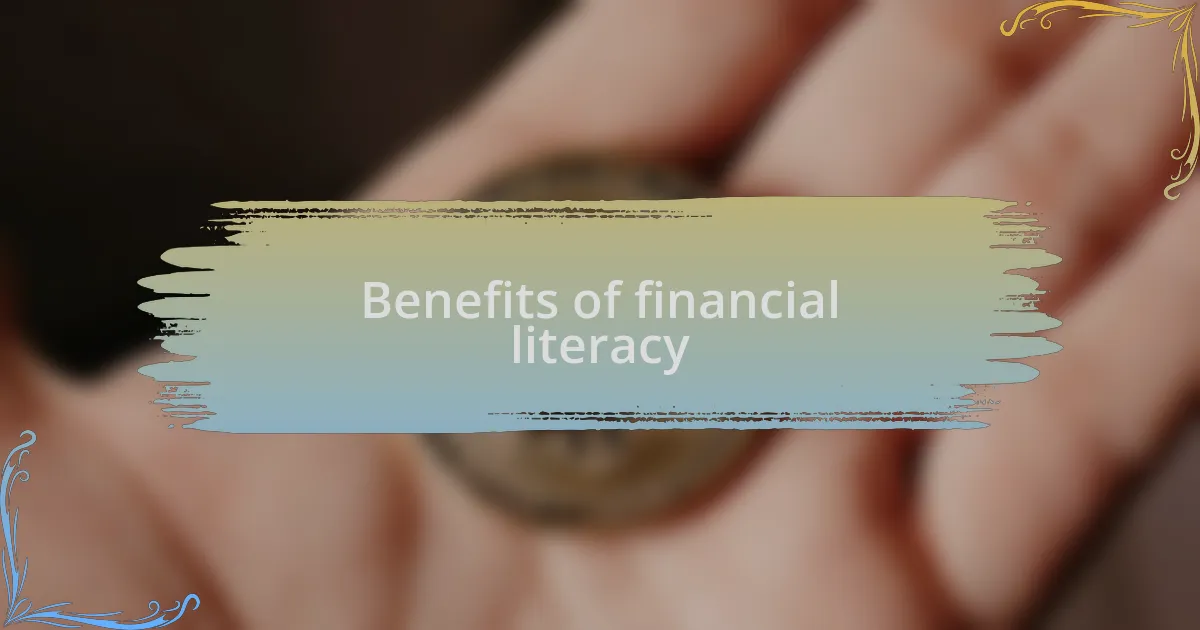
Benefits of financial literacy
Developing financial literacy in children offers lifelong benefits that extend far into adulthood. I remember the day my child successfully saved up enough allowance to buy a handheld game. The pride in their eyes was unmissable; they weren’t just excited about the game, but the sense of accomplishment that came from managing their own money effectively. It was a real-life lesson that taught them the value of patience and planning.
Understanding money management builds a strong foundation for making informed decisions. When my child attempted to budget for a new bike, we discussed the importance of distinguishing between wants and needs. This exercise didn’t just teach them about the bike; it fostered critical thinking skills. I’m sure you can see how these skills are invaluable as children become adults navigating a complex financial world.
Incorporating financial literacy into daily life can be as simple as discussing the family budget or exploring savings options together. I found that allowing my child to participate in small financial decisions made them more aware of the costs associated with everyday items. Have you ever watched a child connect the dots between earning, saving, and spending? It can feel like a light bulb moment, showing them that money is not just a resource but a tool for achieving their dreams.
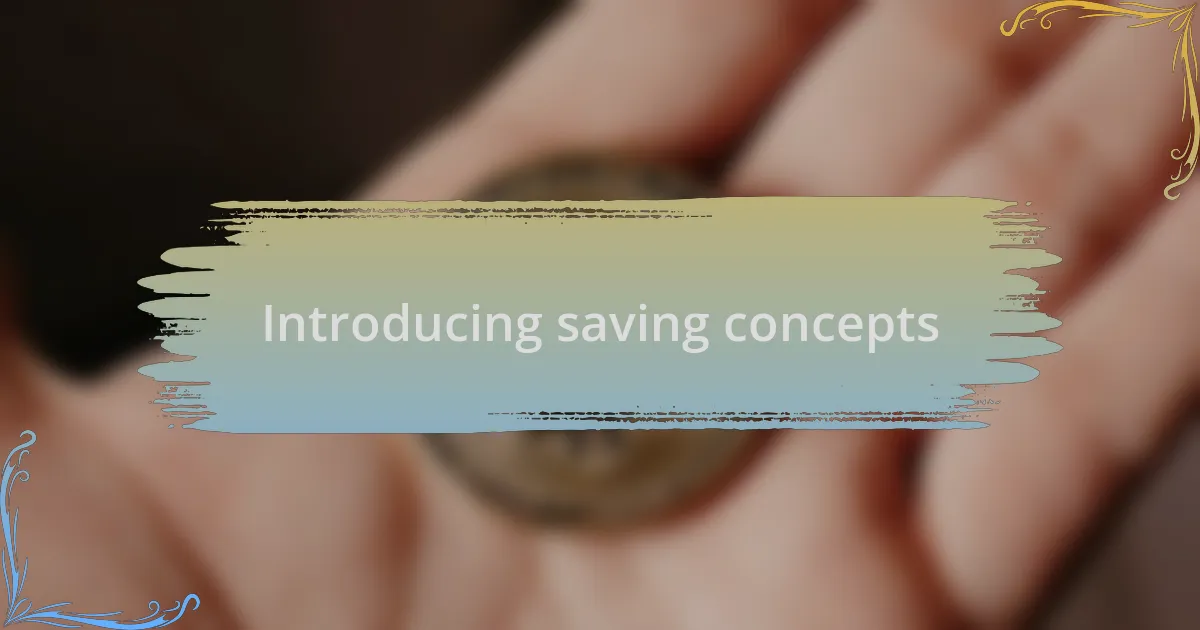
Introducing saving concepts
Introducing saving concepts can begin in surprisingly simple ways. One day, while sorting through some old toys, we stumbled upon a piggy bank that had been left forgotten on a shelf. I decided it was the perfect opportunity to engage my child in a conversation about saving. We filled it with spare change together, and I could see their eyes light up at the thought of turning those coins into something meaningful. Have you ever noticed how tangible savings can spark a child’s imagination about future possibilities?
I also introduced saving goals by creating a colorful chart for my child to track their progress. We decided on a small prize, like a toy or a book, that they could buy once they reached a certain amount. Each time they added to the chart, I could feel their excitement grow. It was amazing to witness the shift in their mindset—saving became an adventure rather than a chore. How rewarding is it to see children connecting their efforts with their rewards in such a hands-on way?
Explaining concepts like interest in a relatable manner can also enhance a child’s understanding of saving. I told a story about how their favorite character from a book managed to save for a magical treehouse by setting aside a bit of their candy each week. This not only captured their interest but illustrated how patience can lead to greater rewards. Have you considered using stories or characters to make financial concepts resonate with your child? It’s fascinating how such connections can instill lifelong lessons in a fun, engaging way.
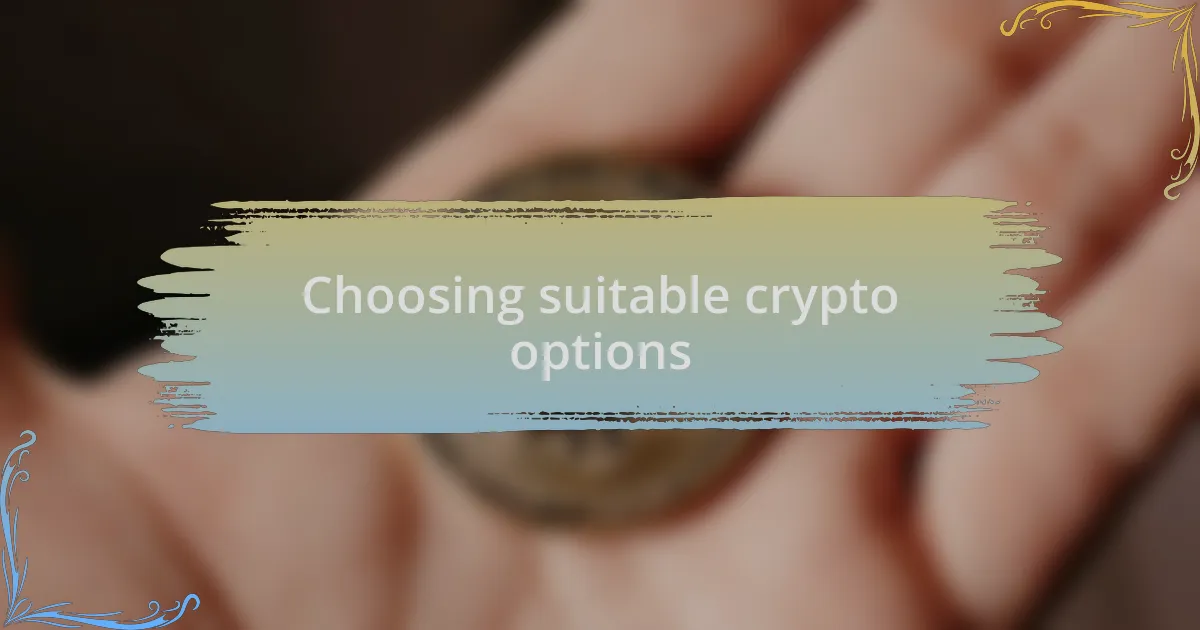
Choosing suitable crypto options
When it comes to selecting suitable crypto options for kids, I found myself navigating through a maze of choices. I decided to start with platforms that offer child-friendly interfaces and educational content. For instance, I came across a crypto app designed specifically for children; its fun graphics and simple explanations made it easy for my child to understand the basics of digital currency. Do you remember the excitement of playing a new game for the first time? That’s precisely the thrill I saw in my child’s face.
Educating my child about the risks and rewards of different cryptocurrencies was another important step. I shared my own experiences with investing in a well-established coin versus a newer, more volatile option. It sparked a meaningful conversation about why some options have higher potential returns but also higher risks. Can you recall a moment when you learned something unexpectedly valuable from a shared experience? I think those lessons stick with us.
I also involved my child in the decision-making process when it came to picking a specific coin. After exploring options together, we decided to invest in a project that aligns with their interests, like a platform that helps environmental causes. It was amazing to see them light up knowing their investment could contribute to something positive. Have you considered how empowering it is for children to feel ownership in their financial decisions? The joy on their face was a true testament to the power of engagement.
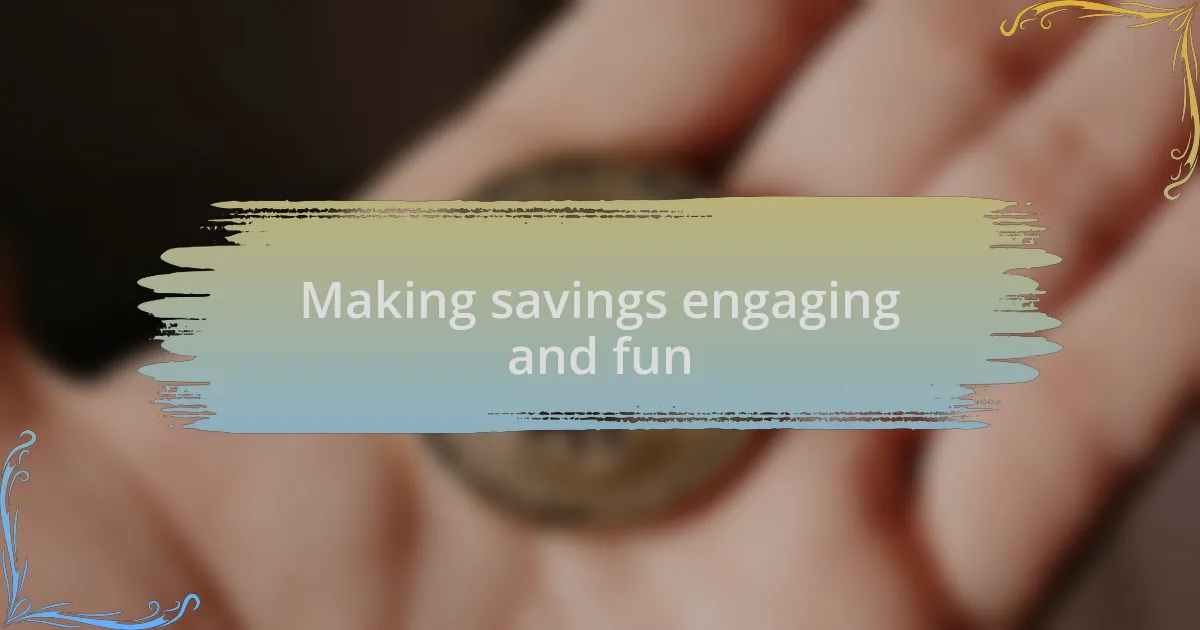
Making savings engaging and fun
Making savings engaging and fun involves turning the concept of saving into a game rather than a chore. One of the strategies I employed was to create a visual savings chart that tracked progress toward our goals. Every time my child added savings, we colored in a section, which transformed the once mundane act of saving into an exciting visual journey. It made me wonder—how often do we overlook the power of simple visuals in conveying progress?
I also noticed that introducing rewards can ignite a child’s enthusiasm for saving. We decided on a small celebration each time we hit a savings milestone, perhaps a fun family outing or a favorite treat. The thrill of saving for something special—paired with the anticipation of a reward—added a layer of excitement to the entire process. Have you ever experienced the joy of working hard for something and then finally getting to enjoy it? That’s the kind of feeling I wanted to instill in my child.
Another idea that resonated deeply was involving my child in age-appropriate financial challenges. We would set small saving goals, turning it into friendly competition—who could save more in a month? One time, after a particularly successful challenge, my child beamed with pride, and I realized how these experiences were not just about saving money; they were about building confidence in their financial abilities. Isn’t it amazing how small steps can lead to significant growth?

Sharing your saving journey
Sharing your saving journey has been one of the most rewarding experiences for both me and my child. I often found myself recounting my own saving experiences—from the first piggy bank I ever owned to the time I saved up for my favorite toy. These stories not only made saving seem relatable but also allowed my child to see that every saver has their own journey, complete with challenges and triumphs. Isn’t it empowering to realize that shared experiences can inspire?
Another way I shared this journey was through casual conversations about our savings progress. We’d sit down over dinner, and I’d ask my child about any goals they were chasing. Just the act of discussing our saving journeys made them feel included in the broader financial narrative of our family. It seems simple, but those moments fostered an open dialogue about money that transformed saving into a family affair rather than an isolated task.
I also employed storytelling through a fun twist: turning our saving anecdotes into bedtime stories. I crafted little tales where characters faced saving challenges, much like our own, leading up to big rewards. As I watched my child’s eyes light up with each story, that magical connection formed—saving became a shared adventure, not just something to check off a list. How delightful it is when our journeys intertwine, turning lessons into laughter along the way!

Tips for ongoing motivation
To keep the motivation alive, I found that setting small, achievable milestones worked wonders. Each time my child reached a goal, like filling up a specific section of their savings jar, we celebrated with a little treat. Wouldn’t it be nice to celebrate progress instead of just the end result? This simple practice not only made saving feel rewarding but also encouraged my child to stay committed to their goals.
Another helpful tip was involving my child in the decision-making process regarding their savings. We would brainstorm together on what to save for next, exploring value and excitement in their choices. I remember the thrill when my child decided to save up for a new video game; the investment felt more personal and engaging. It’s fascinating how empowerment can transform saving from a chore into an empowering experience.
Finally, I discovered that periodic reflections on our saving adventures kept the excitement alive. We would take a few moments to look back on how far we had come, discussing the lessons we learned along the way. I could see the pride in my child’s eyes as they realized their growth, and it made me wonder—how often do we pause to celebrate our progress in life? This practice not only nurtured a sense of achievement but also reinforced the idea that every saving journey is rich with learning opportunities.